| Listing 1 - 10 of 10 |
Sort by
|
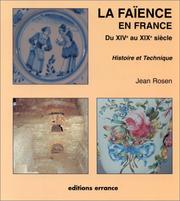
ISBN: 2877721078 2958072606 9782877721073 Year: 1995 Publisher: Paris: Errance,
Abstract | Keywords | Export | Availability | Bookmark
 Loading...
Loading...Choose an application
- Reference Manager
- EndNote
- RefWorks (Direct export to RefWorks)
undefined
Faience --- History. --- Fayence --- History --- Pottery --- Faience - France - History. --- European history --- tin glaze earthenware --- France
Book
ISBN: 311042729X 3110410206 3110410192 9783110410198 Year: 2014 Publisher: Berlin: De Gruyter Open,
Abstract | Keywords | Export | Availability | Bookmark
 Loading...
Loading...Choose an application
- Reference Manager
- EndNote
- RefWorks (Direct export to RefWorks)
Daniel Albero Santacreu presents a wide overview of certain aspects of the pottery analysis and summarizes most of the methodological and theoretical information currently applied in archaeology in order to develop wide and deep analysis of ceramic pastes. The book provides an adequate framework for understanding the way pottery production is organised and clarifies the meaning and role of the pottery in archaeological and traditional societies. The goal of this book is to encourage reflection, especially by those researchers who face the analysis of ceramics for the first time, by providing a background for the generation of their own research and to formulate their own questions depending on their concerns and interests. The three-part structure of the book allows readers to move easily from the analysis of the reality and ceramic material culture to the world of the ideas and theories and to develop a dialogue between data and their interpretation. Daniel Albero Santacreu is a Lecturer Assistant in the University of the Balearic Islands, member of the Research Group Arqueo UIB and the Ceramic Petrology Group. He has carried out the analysis of ceramics from several prehistoric societies placed in the Western Mediterranean, as well as the study of handmade pottery from contemporary ethnic groups in Northeast Ghana.
Chemical & Materials Engineering --- Engineering & Applied Sciences --- Chemical Engineering --- Pottery craft. --- Pottery. --- Ceramic art --- Ceramics (Art) --- Chinaware --- Crockery --- Earthenware --- Pottery, Primitive --- Ceramics --- Decorative arts --- House furnishings --- Firing (Ceramics) --- Saggers --- Pottery making (Handicraft) --- Handicraft --- archaeological ceramic, pottery analysis, pottery production, pottery making, ceramic studies, ceramic raw material, ceramic paste analysis, ceramic technology, archaeometry, ethnoarchaeometry, social theory of technology.
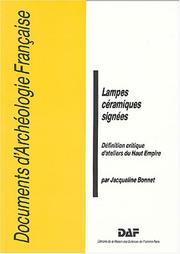
ISBN: 2735102483 2735125629 9782735102488 Year: 1988 Volume: 13 Publisher: Paris : Ed. de la Maison des sciences de l'homme,
Abstract | Keywords | Export | Availability | Bookmark
 Loading...
Loading...Choose an application
- Reference Manager
- EndNote
- RefWorks (Direct export to RefWorks)
Résumé d’une thèse de troisième cycle, cet ouvrage propose une étude originale de lampes romaines du Haut Empire. L’auteur a en effet appliqué à celles-ci une méthode réservée le plus souvent aux vases sigillés, fondée sur l’analyse systématique des associations signature/forme/décor. Le but poursuivi était de vérifier une hypothèse - l’existence de répertoires liés régulièrement, voire de façon spécifique, à chaque signature - et de donner corps, du même coup, à une réalité artisanale : l’atelier. Les résultats obtenus sont très encourageants : des relations privilégiées sont apparues entre divers potiers et l’usage insuffisamment critique que beaucoup font encore des chronologies typologiques a pu être remis en cause. Ce travail appelle la constitution progressive de corpus de référence (marques et poinçons décoratifs) et de répertoires de formes particularisées qui donneront à la lampe sa pleine signification de témoin archéologique et feront sortir de l’obscurité un nouvel artisanat. This work, which summarises the author’s doctoral dissertation, presents an original approach to the study of lamps from the Early Roman Empire. Using a method more often applied to the study of samian pottery, the author has carried out a systematic analysis of the associations of signature, form and decoration. The purpose of the study was to verify a hypothesis, that characteristic types could be associated with a spécifie potter’s signature, and, at the same time, to identify actual workshops. The research is successful not only in demonstrating the existence of significant connections between several potters, but also in questioning the uncritical use, still frequently made, of chronoiogical typologies. The author argues for setting up reference corpora of makers stamps and decorative marks and for cataloguing characteristic forms, thus enabling the lamp to play a significant rôle in the archaeological evidence, as well as bringing to light a new craft.
Lamps, Roman --- Potters --- Lampes romaines --- Céramistes --- History --- Histoire --- Ceramic lamps --- Pottery --- Themes, motives --- Catalogs. --- Marks. --- -Ceramic lamps --- -Pottery --- -Ceramic art --- Ceramics (Art) --- Chinaware --- Crockery --- Earthenware --- Pottery, Primitive --- Ceramics --- Decorative arts --- House furnishings --- Firing (Ceramics) --- Saggers --- Pottery lamps --- Lamps --- Roman lamps --- Lamps, Classical --- -Catalogs --- Marks --- -Themes, motives --- Céramistes --- Ceramic art --- Themes, motives&delete& --- Catalogs --- Lamps [Roman ] --- France --- Lamps, Roman - Themes, motives - Catalogs. --- Ceramic lamps - Themes, motives - Catalogs. --- Pottery - Rome - Marks. --- céramique --- Antiquité --- Haut Empire --- lampe --- estampille --- signature --- poinçon --- moule --- inventaire iconographique
Book
ISBN: 2903189528 2918887331 9782903189525 Year: 1996 Volume: 14 Publisher: Naples: Centre Jean Bérard,
Abstract | Keywords | Export | Availability | Bookmark
 Loading...
Loading...Choose an application
- Reference Manager
- EndNote
- RefWorks (Direct export to RefWorks)
Pottery, Roman --- Pottery, Gallo-Roman --- Expertising --- Congresses. --- Céramique romaine --- -Pottery, Roman --- -738.309377 --- Roman pottery --- Terra-sigillata (Pottery) --- Gallo-Roman pottery --- Arts Ceramic Earthenware and stoneware Ancient world Italian peninsula and addjacent territories Southern Italy --- -Congresses --- 738.309377 --- Classical antiquities --- Pottery, Classical --- Expertising&delete& --- Congresses --- Céramique romaine --- Céramique gallo-romaine --- Congrès --- Pottery, Roman - Expertising - Italy - Campania - Congresses. --- Pottery, Gallo-Roman - Expertising - France - Mediterranean Coast - Congresses. --- céramique --- céramique commune --- archéologie
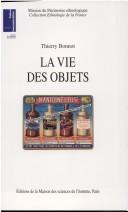
ISSN: 07585888 ISBN: 2735109348 9782735109340 2735118126 Year: 2002 Volume: 22 Publisher: Paris: Maison des sciences de l'homme,
Abstract | Keywords | Export | Availability | Bookmark
 Loading...
Loading...Choose an application
- Reference Manager
- EndNote
- RefWorks (Direct export to RefWorks)
Comment un ustensile banal, fabriqué en série, devient-il objet de patrimoine ? À l’issue de quelles péripéties, presque cent ans après sa sortie de l’usine, se retrouve-t-il, au début du xxiesiècle, dans la vitrine d’un musée ? Peut-on retracer, dans le contexte des productions matérielles des sociétés occidentales, des biographies d’objets ? La notion de biographie permet d’isoler les différentes étapes de la vie des objets en les dépouillant de toute catégorie préalable - marchandise, ustensile, produit ou collection. Elle amène notamment à contester la distinction classique entre la production technique de l’objet industriel et sa production sociale et culturelle. L’enquête ethnologique menée par Thierry Bonnot a porté sur des poteries de grès, des bouteilles à encre, des vases, des cruchons à liqueur et autres accessoires du quotidien, objets matériels saisis dans leur trajectoire individuelle, de l’usine au musée ou aux étagères du salon d’un collectionneur, en passant par l’étal du brocanteur, le grenier ou la cave d’un ancien ouvrier céramiste. En partant de l’exemple de ces productions céramiques de la vallée de la Bourbince (Saône-et-Loire), La vie des objets explore l’évolution du statut d’un ensemble d’objets afin de mieux saisir leurs rôles dans la société occidentale contemporaine. Ce livre analyse ainsi avec une grande finesse les rapports variés que nous entretenons aujourd’hui avec les multiples artefacts que nous manipulons. Il permet de mettre au jour la perception du temps qu’ils impliquent et la manière dont celle-ci se traduit dans notre mode de traitement des choses banales ainsi que dans nos choix de conservation.
History of civilization --- Ethnology. Cultural anthropology --- Implements, utensils, etc --- Pottery --- Material culture --- Instruments, ustensiles, etc --- Céramique --- Culture matérielle --- Social aspects --- Aspect social --- Collectors and collecting --- Ethnology --- Museology --- Collectable tools --- Céramique --- Culture matérielle --- Ceramic art --- Ceramics (Art) --- Chinaware --- Crockery --- Earthenware --- Pottery, Primitive --- Ceramics --- Decorative arts --- House furnishings --- Firing (Ceramics) --- Saggers --- Implements, utensils, etc. --- Social aspects. --- Pottery - France --- Pottery - Collectors and collecting - France --- Objets exposés --- Biens de consommation --- Materiële cultuur. --- Verzamelen. --- Gebruiksvoorwerpen. --- Keramiek. --- Aspect anthropologique. --- 4.280. --- Industries primitives --- Objets usuels --- Anthropologie
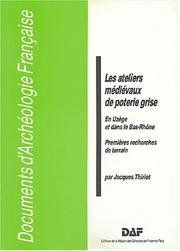
ISBN: 273510186X 2735125645 9782735101863 Year: 1986 Volume: 7 Publisher: Paris : Ed. de la Maison des sciences de l'homme,
Abstract | Keywords | Export | Availability | Bookmark
 Loading...
Loading...Choose an application
- Reference Manager
- EndNote
- RefWorks (Direct export to RefWorks)
Jacques Thiriot, chargé de recherche au CNRS, présente dans cet ouvrage les résultats de l’étude de terrain menée de 1972 à 1979 sur les ateliers médiévaux de poterie grise de l’Uzège et du Bas-Rhône, en particulier sur les sites de Saint-Victor-des-Oules dans le Gard (XIIe - XIIIe s.) et de Bollène dans le Vaucluse (XIIIe s.). Cette étude a permis la mise au point d’une méthodologie adaptée à la fouille et à l’interprétation de ces vestiges (fours et bâtiments) grâce à une analyse technique rigoureuse, ainsi que l’acquisition d’une connaissance exceptionnelle des structures de production de l’une des plus grandes officines médiévales du Sud-Est. Elle vient également compléter très utilement les données typologiques qu’ont fournies les poteries grises découvertes en fouille dans les centres utilisateurs, aussi bien en Languedoc qu’en Provence. Outre son thème peu traité pour la période médiévale, son originalité réside dans le recours systématique aux prospections géophysiques et aux méthodes scientifiques de datation, et dans l’utilisation d’une démarche ethno-archéologique permettant de mieux appréhender les traces de l’activité potière médiévale dans larégion. In this publication, Jacques Thiriot, a research worker with the CNRS, presents the results of the fieldwork carried out between 1972 and 1979 on the mediaeval grey pottery workshops of the Uzege and the Lower Rhone, in particular at Saint-Victor-des-Oules in the Gard (XIIth and XIIIth cent.) and Bollene in the Vaucluse (XIIIth cent.). During this work, a methodology adapted to the excavation and interpretation of the remains (ovens and buildings) was perfected, thanks to a rigorous technical analysis. It provided an exceptional insight into production methods in one of the largest mediaeval potter’s workshops in south-east France. It has also completed typological data based on pottery found during excavations in user centres, not only in Provence but also in Languedoc. Apart from the subject, rarely…
Pottery --- Excavations (Archaeology) --- Céramique --- Fouilles (Archéologie) --- Vaucluse (France : Department) --- Gard (France) --- France --- Antiquities --- Céramique --- Fouilles (Archéologie) --- Pottery [Medieval ] --- Uzege --- Bas-Rhone --- Archaeological digs --- Archaeological excavations --- Digs (Archaeology) --- Excavation sites (Archaeology) --- Ruins --- Sites, Excavation (Archaeology) --- Archaeology --- Ceramic art --- Ceramics (Art) --- Chinaware --- Crockery --- Earthenware --- Pottery, Primitive --- Ceramics --- Decorative arts --- House furnishings --- Firing (Ceramics) --- Saggers --- Antiquities. --- Département du Gard (France) --- Vaucluse (France : Dept.) --- Comtat Venaissin (France) --- Pottery - France - Vaucluse (Department) --- Pottery - France - Gard --- Excavations (Archaeology) - France - Vaucluse (Department) --- Vaucluse (France : Department) - Antiquities --- Gard (France) - Antiquities --- France - Antiquities --- poterie --- céramique --- Moyen Âge --- atelier --- four --- Uzège --- Bas-Rhône --- Bollène --- Saint-Victor-des-Oules --- Saint-Blaise-de-Bauzon

ISBN: 2735102505 273512567X 9782735102501 Year: 1988 Volume: 14 Publisher: Paris: Maison des sciences de l'homme,
Abstract | Keywords | Export | Availability | Bookmark
 Loading...
Loading...Choose an application
- Reference Manager
- EndNote
- RefWorks (Direct export to RefWorks)
Cette publication est l’aboutissement d’une série de fouilles de sauvetage effectuées à Feurs (Loire) de 1978 à 1981.0 les ont révélé la présence, antérieure à la ville antique, d’une agglomération gauloise dont l’apogée se situe à La Téne finale. Son existence était jusqu’alors totalement méconnue, la fondation augustéenne de la capitale de la cité ségusiave. Forum Segusiavorum, étant considérée comme une création impériale ex nihilo. Ce travail, fondé sur l’étude systématique d’abondantes séries de mobiliers, permet d’esquisser les modalités de l’évolution de l’habitat gaulois sous ses divers aspects durant tout le siècle qui précède la conquête césarienne. Replacé dans le contexte de la Gaule interne, le site de Feurs apparaît comme un élément important dans notre connaissance de la civilisation gauloise à la fin de l’âge du Fer. This work is the result of rescue archaeology carried out at Feurs (Loire) from 1978 to 1981. A series of excavations on the site of the Roman town revealed an earlier Gaulish settlement at its height during the late La Tène period. The discovery of evidence of pre-Roman occupation was completely unexpected since the cantonal capital of the Segusiavi, Forum Segusiavorum, was founded by Augustus and its origins were assumed to date from this period. Based upon the systematic analysis of a large number of finds series, the author’s study outlines how the different aspects of the Gaulish settlement of the site developed during the century preceding Caesar’s conquest. Seen within the context of inner Gaul, Feurs is of fundamental importance to our understanding of Gaulish civilisation at the end of the Iron Age.
Excavations (Archaeology) --- Fouilles (Archéologie) --- Feurs (France) --- Antiquities --- Antiquités --- Pottery --- Celts --- La Tene period --- Catalogs. --- % 9611AR --- La Tène period --- Fouilles (Archéologie) --- Antiquités --- Catalogs --- La Tène period --- Iron age --- Archaeological digs --- Archaeological excavations --- Digs (Archaeology) --- Excavation sites (Archaeology) --- Ruins --- Sites, Excavation (Archaeology) --- Archaeology --- Celtic peoples --- Gaels --- Ethnology --- Indo-Europeans --- Alpine race --- Ceramic art --- Ceramics (Art) --- Chinaware --- Crockery --- Earthenware --- Pottery, Primitive --- Ceramics --- Decorative arts --- House furnishings --- Firing (Ceramics) --- Saggers --- Gaul --- Gallia --- Gaule --- Antiquities, Celtic --- Pottery - Gaul - Catalogs. --- Celts - France - Feurs. --- Excavations (Archaeology) - France - Feurs - Catalogs. --- La Tene period - France - Feurs. --- culture --- habitat --- économie --- monnaie --- faune --- céramique --- chronologie --- armes --- parure --- métal --- Tène finale --- Feurs --- pays ségusiave
Book

ISBN: 2380500312 2380500223 9782380500318 9782380500226 Year: 2021 Publisher: Naples : Publications du Centre Jean Bérard,
Abstract | Keywords | Export | Availability | Bookmark
 Loading...
Loading...Choose an application
- Reference Manager
- EndNote
- RefWorks (Direct export to RefWorks)
Reports on the restoration efforts of the red-figure vase or Loutrophoros apula with representation of the "Myth of Niobe" (MANN, inv. 82267), attributed to the Painter of Varrese and dated to 350-340 BC approx.; and the red-figure Apulian krater vase known as the "Vase of the Amazonomachy" (MANN, inv. 81667), by the Darius painter, dating back to 330 BC. approx.
Potters --- Vases, Red-figured --- Vase-painting --- Pottery, Italic --- Pottery --- Loutrophoroi --- Vases, Apulian --- Niobe --- History --- Conservation and restoration --- Darius painter, --- Varrese Painter --- battle between Greeks and Amazons --- mazzonomachia vase --- red-figured vases --- Apulian vases --- Antiquities --- Vases --- Vases, Greek --- Red-figure vases --- Red-figured vases --- Vases, Red-figure --- Vases, Ancient --- Ceramic artists --- Jiggermen --- Artists --- Ceramic art --- Ceramics (Art) --- Chinaware --- Crockery --- Earthenware --- Pottery, Primitive --- Ceramics --- Decorative arts --- House furnishings --- Firing (Ceramics) --- Saggers --- Italic pottery --- Decoration and ornament --- Painting --- Darius, --- Peintre de Darius, --- Potters. --- Pottery. --- Loutrophoroi. --- Vases, Red-figured. --- Vases, Apulian. --- Conservation and restoration.
Book
ISBN: 9782728310975 2728310971 272831098X Year: 2016 Volume: 513 Publisher: Roma: École française de Rome,
Abstract | Keywords | Export | Availability | Bookmark
 Loading...
Loading...Choose an application
- Reference Manager
- EndNote
- RefWorks (Direct export to RefWorks)
La 4e de couv. indique : "La romanisation est pour les archéologues une question complexe qui touche tant à la notion d’identité qu’aux problèmes inhérents à l’interprétation des témoins de la culture matérielle. Durant les vingt dernières années, l’étude de la romanisation s’est enrichie de bon nombre de publications importantes traitant de presque toutes les provinces de l’Empire romain, marquant une avancée significative dans l’élucidation des modalités diverses de ce processus. Le territoire retenu comme objet d’étude par le présent travail se situe à la charnière des provinces balkano-danubiennes et grecques. Le matériel archéologique disponible, à la fois volumineux et diversifié (monnaies, céramiques, inscriptions), confronté aux structures urbaines mises à jour par les fouilles et à la dynamique de l’habitat rural permet d’éclairer d’un jour nouveau bien des composantes de la vie quotidienne durant la période romaine. L’analyse de l’ensemble de ces éléments permet d’offrir non seulement de nouvelles analyses de caractère archéologique, mais également une synthèse historique dont l’objectif essentiel est la mise en évidence du processus d’intégration des Illyriens et des Épirotes à l’Empire romain et des transformations qui s’en sont suivies pour leur civilisation."
Romans --- Romains --- Illyria --- Epirus (Greece and Albania) --- Albania --- Illyrie --- Epire (Grèce et Albanie) --- Albanie --- Antiquities, Roman --- Antiquités romaines --- Antiquities, Roman. --- Civilization --- Roman influences. --- Roman influences --- Epire (Grèce et Albanie) --- Antiquités romaines --- Romanisation --- Inscriptions --- Coins --- Pottery --- Antiquities. --- Classical antiquities. --- Coins. --- Inscriptions. --- Pottery. --- Romans. --- Rome --- Europe --- Rome (Empire) --- History, Military. --- Antiquities --- Classical antiquities --- Ceramic art --- Ceramics (Art) --- Chinaware --- Crockery --- Earthenware --- Pottery, Primitive --- Ceramics --- Decorative arts --- House furnishings --- Firing (Ceramics) --- Saggers --- Money --- Numismatics --- Epigraphs (Inscriptions) --- Epigraphy --- Inscription --- Paleography --- Epigraphists --- Ethnology --- Italic peoples --- Latini (Italic people) --- Epir (Greece and Albania) --- Ípiros (Greece and Albania) --- Illyricum --- Illyria - Antiquities, Roman --- Epirus (Greece and Albania) - Antiquities, Roman. --- Illyria - Civilization - Roman influences. --- Epirus (Greece and Albania) - Civilization - Roman influences --- archéologie romaine
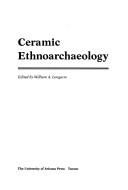
ISBN: 0816511985 0816548773 Year: 2022 Publisher: University of Arizona Press
Abstract | Keywords | Export | Availability | Bookmark
 Loading...
Loading...Choose an application
- Reference Manager
- EndNote
- RefWorks (Direct export to RefWorks)
Ethnoarchaeology, the study of material culture in a living society by archaeologists, facilitates the extraction of information from prehistoric materials as well. Studies of contemporary pottery-making were initiated in the southwestern United States toward the end of the nineteenth century, then abandoned as a result of changes in archaeological theory. Now a resurgence in ethnoarchaeology over the past twenty-five years offers a new set of directions for the discipline. This volume presents the results of such work with pottery, a class of materials that occurs abundantly in many archaeological sites. Drawing on projects undertaken around the world, in the Phillipines, East Africa, Mesoamerica, India, in both traditional and complex societies, the contributors focus on identifying social and behavioral sources of ceramic variation to show how analogical reasoning is fundamental to archaeological interpretation. As the number of pottery-making societies declines, opportunities for such research must be seized. By bringing together a variety of ceramic ethnoarchaeological analyses, this volume offers the profession a much-needed touchstone on method and theory for the study of pottery-making among living peoples.
Ethnoarchaeology --- Congresses --- Pottery --- Analysis --- Congresses. --- Ethnoarcheologie --- Ceramique --- Keramiek. --- Etnoarcheologie. --- Ethnoarchaeology. --- Congres. --- Analysis. --- Analyse --- Ceramic art --- Ceramics (Art) --- Chinaware --- Crockery --- Earthenware --- Pottery, Primitive --- Ceramics --- Decorative arts --- House furnishings --- Firing (Ceramics) --- Saggers --- Ethnic archaeology --- Ethnicity in archaeology --- Ethnology in archaeology --- Archaeology --- Ethnology --- Social archaeology --- Art céramique --- Céramique d'art --- Céramique domestique --- Céramiques --- Contribution à la céramique --- Oeuvres --- Poterie --- Poteries --- Céramique --- Céramique industrielle --- Céramistes --- Fours à céramique --- Moules céramiques --- Sculpture en céramique --- Tours de potiers --- Barbotine (céramique) --- Biscuit (céramique) --- Céladon --- Céramique antique --- Céramique architecturale --- Céramique d'artistes --- Céramique de la Renaissance --- Céramique en décoration intérieure --- Céramique lustrée --- Céramique médiévale --- Céramique noire --- Céramique préhistorique --- Céramique vernissée --- Engobes --- Faïence --- Grès (céramique) --- Porcelaine --- Sifflet de céramique --- Terres cuites --- Vaisselle en céramique --- Arts du feu --- Archéologie et ethnologie --- Ethnologie archéologique --- Anthropologie historique --- Archéologie sociale --- Société préhistorique --- Archéologie --- Ethnologie --- Methodology --- Décoration --- Industrie et commerce --- Marques --- Marques de propriété --- Technique --- [Localisations géographiques] --- Méthodologie --- Society & culture: general --- Archéologie communautaire --- Ethnoarchéologie
| Listing 1 - 10 of 10 |
Sort by
|

 Search
Search Feedback
Feedback About UniCat
About UniCat  Help
Help News
News